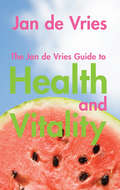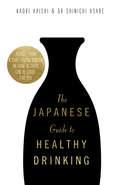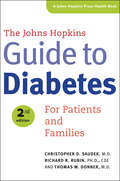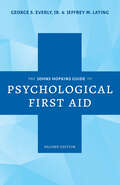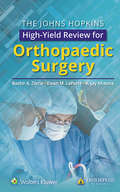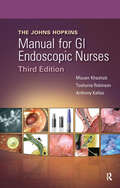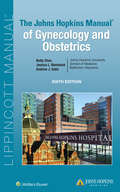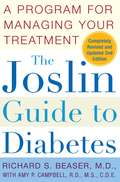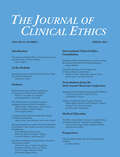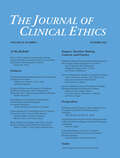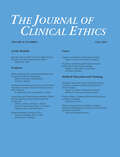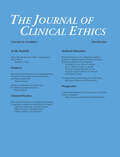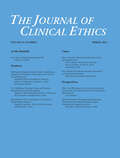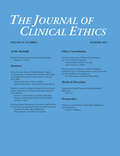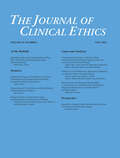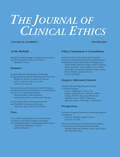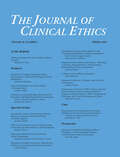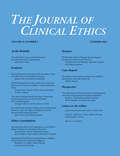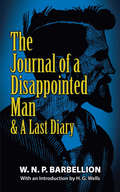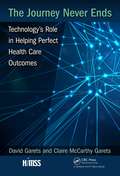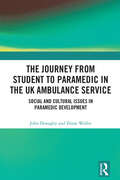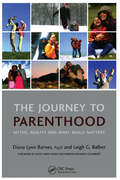- Table View
- List View
The Jan de Vries Guide to Health and Vitality
by Jan de VriesThis helpful and informative new publication by world-renowned alternative health guru Jan de Vries is a straightforward and constructive guide to maintaining good health by natural means. Packed full of useful tips and revealing new case studies, the book covers a wide range of issues and offers advice on how to: keep fit and healthy; give up common addictions such as alcohol, nicotine, caffeine and sugar; prevent allergies; enjoy exercise and maintain a healthy digestive system. Jan de Vries also suggests natural ways to cultivate healthy skin, hair and nails, relieve stress and boost the immune system. He also provides some important new information on dealing with Alzheimer's disease. Added to these tips, there is further advice on how to standardise sleeping patterns, ways to achieve optimum sexuality and fertility, and the best means of obtaining an overall sense of health, happiness and vitality in the long term.
The Japanese Guide to Healthy Drinking: Advice from a Saké-loving Doctor on How Alcohol Can Be Good for You
by Kaori Haishi Dr Shinichi Asabe'People in Japan take their drink seriously. But alcohol is seriously bad for you. This book will tell you how to hold your drink - without dying from the consequences'HENRY GEE, Senior Editor, Nature, and author of The Accidental Species: Misunderstandings of Human Evolution'Drinking can be one of life's great pleasures, but it can also be very harmful and dangerous. Here is a sensible, science-driven, and thought-provoking look at both the pluses and minuses of alcohol as well as tips on how to hopefully enjoy your favourite tipple in a safer way. Kanpai!'BRIAN ASHCRAFT, author of The Japanese Saké Bible and Japanese Whisky 'A refreshingly honest look at booze and how to get the best out of it. I can definitely drink to that.'HELEN McGINN, author of The Knackered Mother's Wine ClubALCOHOL CAN BE GOOD FOR YOU!In this uniquely Japanese mix of quirky fun and hard science, alcohol is revealed not as a poison, but as the best of all medicines . . . up to a point. If we drink healthily, drinkers need never give up what we love. Kaori Haishi is a journalist and the director of the Japan Saké Association; Dr Shinichi Asabe is a liver specialist who likes a drink. Kaori Haishi interviewed a line-up of twenty-five booze-loving physicians, including Japan's leading expert on throwing up, a sleep specialist on how nightcaps can cause depression and a professor on how drinking too much beer can prevent the secretion of testosterone. Now, with Dr Asabe's expert medical help, she has written this book. Universally relevant information about the effects of wines, beers and spirits on the human body is delivered with clarity and precision, backed up by plentiful footnotes citing the latest academic research. The unfailingly amusing Haishi has particularly empathetic advice for women, including the merits of saké as a miracle skin-care product. The book explores all sorts of issues, such as:Bitter Medicine - how beer can help to prevent dementia.Shakes on a Plane - is in-flight drinking dangerous?Mellow Yellow - checking the colour of your pee.Snack Attacks - secrets for avoiding weight gain.And that perennial mystery . . . how do the French get away with it?
The Japanese Guide to Healthy Drinking: Advice from a Saké-loving Doctor on How Alcohol Can Be Good for You
by Kaori Haishi Shinichi Dr Shinichi Asabe Shinichi Asabe'People in Japan take their drink seriously. But alcohol is seriously bad for you. This book will tell you how to hold your drink - without dying from the consequences'HENRY GEE, Senior Editor, Nature, and author of The Accidental Species: Misunderstandings of Human Evolution'Drinking can be one of life's great pleasures, but it can also be very harmful and dangerous. Here is a sensible, science-driven, and thought-provoking look at both the pluses and minuses of alcohol as well as tips on how to hopefully enjoy your favourite tipple in a safer way. Kanpai!'BRIAN ASHCRAFT, author of The Japanese Saké Bible and Japanese Whisky'A refreshingly honest look at booze and how to get the best out of it. I can definitely drink to that.'HELEN McGINN, author of The Knackered Mother's Wine ClubALCOHOL CAN BE GOOD FOR YOU!In this uniquely Japanese mix of quirky fun and hard science, alcohol is revealed not as a poison, but as the best of all medicines . . . up to a point. If we drink healthily, drinkers need never give up what we love. Kaori Haishi is a journalist and the director of the Japan Saké Association; Dr Shinichi Asabe is a liver specialist who likes a drink. Kaori Haishi interviewed a line-up of twenty-five booze-loving physicians, including Japan's leading expert on throwing up, a sleep specialist on how nightcaps can cause depression and a professor on how drinking too much beer can prevent the secretion of testosterone. Now, with Dr Asabe's expert medical help, she has written this book. Universally relevant information about the effects of wines, beers and spirits on the human body is delivered with clarity and precision, backed up by plentiful footnotes citing the latest academic research. The unfailingly amusing Haishi has particularly empathetic advice for women, including the merits of saké as a miracle skin-care product. The book explores all sorts of issues, such as:Bitter Medicine - how beer can help to prevent dementia.Shakes on a Plane - is in-flight drinking dangerous?Mellow Yellow - checking the colour of your pee.Snack Attacks - secrets for avoiding weight gain.And that perennial mystery . . . how do the French get away with it?
The Johns Hopkins Guide to Diabetes: For Patients and Families (A Johns Hopkins Press Health Book)
by Christopher D. Saudek Richard R. Rubin Thomas W. DonnerA comprehensive and up-to-date guide to the physically, emotionally, and psychologically challenging disease of diabetes.Living with diabetes is a balancing act of monitoring blood glucose, food intake, and medication. It makes sense that individuals who have diabetes do best when they understand their condition and how to control it.The Johns Hopkins Guide to Diabetes is a comprehensive and easy-to-read guide to this complex condition, answering questions such as: What are the differences between Type 1 and Type 2 diabetes? How are the different forms of this disease treated? Can gestational diabetes become a permanent condition? Can diabetes ever be managed successfully with diet and exercise alone? The second edition of this valued resource includes up-to-date information on• How diabetes is diagnosed• The two types of diabetes• The role of genetics • Improvements in blood glucose measurement• Good nutrition and regular exercise• Insulin and non-insulin medications• Insulin pumps• The emotional side of diabetes• How families are affected and how they can help• What to do if diabetes affects your work• Complications from head to toeWritten by a team of Johns Hopkins diabetes specialists, this authoritative guide will help people who have diabetes work effectively with their care team to control their diabetes and maintain good health.
The Johns Hopkins Guide to Psychological First Aid
by George S. Everly Jr. Jeffrey M. LatingLearn the essential skills of psychological first aid from the expert who created the Johns Hopkins RAPID PFA method.Psychological first aid, or PFA, is designed to mitigate the effects of acute stress and trauma and assist those in crisis to cope effectively with adversity. PFA is designed to be applied in emergencies, including disasters and terrorist attacks. In this essential guide, George S. Everly, Jr., developer of the Johns Hopkins RAPID PFA method, and Jeffrey M. Lating, his collaborator in its implementation, describe the principles and practices underpinning this psychological model in an easy-to-follow, prescriptive, and practical manner. They explain the history of PFA and persuasively demonstrate its powerful versatility. Mental health practitioners can apply PFA in all settings. It can also be used as a public-health tool to address mental health needs following critical incidents and as a means for building community resilience.Aimed at mental health practitioners, all first responders, and global health disaster teams such as Médecins Sans Frontières and the World Health Organization, The Johns Hopkins Guide to Psychological First Aid is the first book to thoroughly explain RAPID PFA. RAPID, a unique theoretically grounded and evidence-based PFA method, follows a set of easily understood principles. In each chapter, Everly and Lating provide a step-by-step approach and include a key point summary to emphasize essential elements. A unifying case exemplifies each phase of the RAPID PFA model in an ongoing dialogue that presents ideal PFA responses, examples of common mistakes, and various outcomes.In addition to their counseling experience in Kuwait after the Gulf War and in New York City after the September 11 attacks, the authors have traveled nationally and internationally to teach the RAPID PFA method in numerous public health, fire, police, military, and faith-based settings. Beneficial to those with little or no previous mental health training, this book is an essential tool for people who want to learn, to practice, or to retain their ability to use psychological first aid effectively.
The Johns Hopkins Guide to Psychological First Aid
by George S. Everly Jr. Jeffrey M. LatingLearn the essential skills of psychological first aid from the experts—the creators of the Johns Hopkins RAPID PFA method.Psychological first aid, or PFA, is designed to mitigate the effects of acute stress and trauma and assist those in crisis to cope effectively. PFA can be applied in emergencies, including disasters, terrorist attacks, and the COVID-19 pandemic. In the second edition of this essential guide, George S. Everly, Jr., and Jeffrey M. Lating draw on their experiences in Kuwait after the Gulf War, in New York City after the September 11 attacks, and during the COVID-19 pandemic to describe the principles and practices of PFA in an easy-to-follow, prescriptive, and practical manner. Informed by current events, the second edition includes updated chapters as well as three completely new chapters on • cultural awareness• PFA considerations with children• the use of PFA to facilitate community mental health and resilienceAimed at mental health practitioners, first responders, and global health disaster teams such as Médecins Sans Frontières and the World Health Organization, but also beneficial to those with little or no previous mental health training, The Johns Hopkins Guide to Psychological First Aid thoroughly explains RAPID PFA. RAPID, a unique evidence-informed and evidence-based PFA method, follows a set of easily understood principles. In each chapter, Everly and Lating—who have traveled nationally and internationally to teach the RAPID PFA model in numerous public health, fire, police, military, business, and faith-based settings—provide a step-by-step approach and include a key point summary. A unifying case exemplifies each phase of the RAPID PFA model in an ongoing dialogue that presents ideal PFA responses, examples of common mistakes, and various outcomes.
The Johns Hopkins High-Yield Review for Orthopaedic Surgery
by Bashir ZikriaThe Johns Hopkins High-Yield Review for Orthopaedic Surgery is a compact, concise study tool to help residents prepare for Part 1 of the American Board of Orthopaedic Surgery (ABOS) examination and the Orthopaedic In-Training Examination (OITE). The book is also ideal for seasoned clinicians studying for the ABOS recertification exams and motivated medical students preparing for orthopaedic surgery rotations. With its numerous illustrations, streamlined structure and heavily bulleted text, the book is designed as a ‘memory-jogger’ to supplement basic knowledge of fundamental orthopaedic surgery principles and procedures.
The Johns Hopkins Manual for GI Endoscopic Nurses
by Mouen Khashab Toshunia Robinson Anthony KallooThe Johns Hopkins Manual for GI Endoscopic Nurses, Third Edition outlines nursing care before, during, and after endoscopic procedures. Written with both the novice and experienced nurse in mind, the Third Edition of The Johns Hopkins Manual for GI Endoscopic Nurses provides practical tips for all basic and advanced endoscopic procedures.Dr. Anthony Kalloo is joined by Mouen Khashab and Toshunia Robinson on the Third Edition of this popular manual. The Johns Hopkins Manual for GI Endoscopic Nurses features up-to-date guides to new endoscopic procedures and techniques, such as fiducial placement, balloon-assisted enteroscopy, Barrett’s ablation, Spyglass cholangioscopy, and pancreatoscopy. Additional chapters cover sedation, antibiotic prophylaxis, disinfection, and the management of patients on anticoagulation medication.General guidelines for moderate sedation, equipment disinfection, and sterilization are also discussed, as well as special considerations for patients with specific medical conditions who are undergoing endoscopy.Endoscopy nurses, gastroenterology fellows, and gastroenterology practitioners alike can use The Johns Hopkins Manual for GI Endoscopic Nurses, Third Edition’s endoscopic preparation regimens to facilitate the correct instruction of patients, reducing the likelihood of unsuccessful procedures. This spiral-bound resource also includes the definitions and indications for both common and advanced endoscopic procedures along with listings of necessary equipment.The Johns Hopkins Manual for GI Endoscopic Nurses, Third Edition is easy to read and comprehend, with photographs and illustrations replacing cumbersome long descriptions, making this the ideal reference for a nurse on the go.
The Johns Hopkins Manual of Gynecology and Obstetrics
by Betty ChouPortable and easy to consult, The Johns Hopkins Manual of Gynecology and Obstetrics is a trusted on-the-spot reference for virtually any issue you’ll encounter in obstetrics, high-risk obstetrics, gynecology, reproductive endocrinology, infertility, and gynecologic oncology. The updated 6th Edition has been reorganized for quick reference, and contains thoroughly revised information culled from the collective expertise of residents and attending physicians at The Johns Hopkins University.
The Joslin Guide to Diabetes
by Richard S. Beaser Amy P. CampbellFinding out that you have diabetes immediately raises questions about the condition, its treatment, and its impact on your future. Why did I get diabetes? What will I have to do to treat it? How will my future health be affected by having diabetes? What will my life be like? Getting accurate answers to these and many other questions will determine how well you are able to live with diabetes. This completely updated edition of The Joslin Guide to Diabetes will help provide the answers you need. It's an easy-to-understand resource that explains not only the types of diabetes treatment but also every aspect of diabetes self-management, including: Meal planning and carbohydrate counting Monitoring blood glucose Administering insulin and taking oral medications Treating high and low blood glucose Using physical activity to help control diabetes, maintain good health, and reduce the chances of future problems Successfully fitting diabetes into your lifestyle Based upon research and the clinical experience of the world-renowned Joslin Diabetes Center and written by physician and diabetes expert Richard S. Beaser, M.D., and nutritionist and diabetes educator Amy Campbell, R.D., M.S., C.D.E., this book will help those with diabetes integrate the medical treatments and lifestyle changes necessary to learn how to live healthfully with this condition.
The Journal of Clinical Ethics, volume 34 number 1 (Spring 2023)
by The Journal of Clinical EthicsThis is volume 34 issue 1 of The Journal of Clinical Ethics. The Journal of Clinical Ethics is uniquely focused on ethical issues that arise in direct patient care, in the clinic and at the bedside, as well as with related issues and challenges in the broader practice of medicine, healthcare delivery, and best practices. The journal engages with issues of primary concern to physicians and patients—and families—and all members of the clinical team, including allied professionals in ethics consultation, as well as scholars and professionals in diverse disciplines and care-related practices: philosophy, law, theology, public and health policy, nursing, and organizational ethics.
The Journal of Clinical Ethics, volume 34 number 2 (Summer 2023)
by The Journal of Clinical EthicsThis is volume 34 issue 2 of The Journal of Clinical Ethics. The Journal of Clinical Ethics is uniquely focused on ethical issues that arise in direct patient care, in the clinic and at the bedside, as well as with related issues and challenges in the broader practice of medicine, healthcare delivery, and best practices. The journal engages with issues of primary concern to physicians and patients—and families—and all members of the clinical team, including allied professionals in ethics consultation, as well as scholars and professionals in diverse disciplines and care-related practices: philosophy, law, theology, public and health policy, nursing, and organizational ethics.
The Journal of Clinical Ethics, volume 34 number 3 (Fall 2023)
by The Journal of Clinical EthicsThis is volume 34 issue 3 of The Journal of Clinical Ethics. The Journal of Clinical Ethics is uniquely focused on ethical issues that arise in direct patient care, in the clinic and at the bedside, as well as with related issues and challenges in the broader practice of medicine, healthcare delivery, and best practices. The journal engages with issues of primary concern to physicians and patients—and families—and all members of the clinical team, including allied professionals in ethics consultation, as well as scholars and professionals in diverse disciplines and care-related practices: philosophy, law, theology, public and health policy, nursing, and organizational ethics.
The Journal of Clinical Ethics, volume 34 number 4 (Winter 2023)
by The Journal of Clinical EthicsThis is volume 34 issue 4 of The Journal of Clinical Ethics. The Journal of Clinical Ethics is uniquely focused on ethical issues that arise in direct patient care, in the clinic and at the bedside, as well as with related issues and challenges in the broader practice of medicine, healthcare delivery, and best practices. The journal engages with issues of primary concern to physicians and patients—and families—and all members of the clinical team, including allied professionals in ethics consultation, as well as scholars and professionals in diverse disciplines and care-related practices: philosophy, law, theology, public and health policy, nursing, and organizational ethics.
The Journal of Clinical Ethics, volume 35 number 1 (Spring 2024)
by The Journal of Clinical EthicsThis is volume 35 issue 1 of The Journal of Clinical Ethics. The Journal of Clinical Ethics is uniquely focused on ethical issues that arise in direct patient care, in the clinic and at the bedside, as well as with related issues and challenges in the broader practice of medicine, healthcare delivery, and best practices. The journal engages with issues of primary concern to physicians and patients—and families—and all members of the clinical team, including allied professionals in ethics consultation, as well as scholars and professionals in diverse disciplines and care-related practices: philosophy, law, theology, public and health policy, nursing, and organizational ethics.
The Journal of Clinical Ethics, volume 35 number 2 (Summer 2024)
by The Journal of Clinical EthicsThis is volume 35 issue 2 of The Journal of Clinical Ethics. The Journal of Clinical Ethics is uniquely focused on ethical issues that arise in direct patient care, in the clinic and at the bedside, as well as with related issues and challenges in the broader practice of medicine, healthcare delivery, and best practices. The journal engages with issues of primary concern to physicians and patients—and families—and all members of the clinical team, including allied professionals in ethics consultation, as well as scholars and professionals in diverse disciplines and care-related practices: philosophy, law, theology, public and health policy, nursing, and organizational ethics.
The Journal of Clinical Ethics, volume 35 number 3 (Fall 2024)
by The Journal of Clinical EthicsThis is volume 35 issue 3 of The Journal of Clinical Ethics. The Journal of Clinical Ethics is uniquely focused on ethical issues that arise in direct patient care, in the clinic and at the bedside, as well as with related issues and challenges in the broader practice of medicine, healthcare delivery, and best practices. The journal engages with issues of primary concern to physicians and patients—and families—and all members of the clinical team, including allied professionals in ethics consultation, as well as scholars and professionals in diverse disciplines and care-related practices: philosophy, law, theology, public and health policy, nursing, and organizational ethics.
The Journal of Clinical Ethics, volume 35 number 4 (Winter 2024)
by The Journal of Clinical EthicsThis is volume 35 issue 4 of The Journal of Clinical Ethics. The Journal of Clinical Ethics is uniquely focused on ethical issues that arise in direct patient care, in the clinic and at the bedside, as well as with related issues and challenges in the broader practice of medicine, healthcare delivery, and best practices. The journal engages with issues of primary concern to physicians and patients—and families—and all members of the clinical team, including allied professionals in ethics consultation, as well as scholars and professionals in diverse disciplines and care-related practices: philosophy, law, theology, public and health policy, nursing, and organizational ethics.
The Journal of Clinical Ethics, volume 36 number 1 (Spring 2025)
by The Journal of Clinical EthicsThis is volume 36 issue 1 of The Journal of Clinical Ethics. The Journal of Clinical Ethics is uniquely focused on ethical issues that arise in direct patient care, in the clinic and at the bedside, as well as with related issues and challenges in the broader practice of medicine, healthcare delivery, and best practices. The journal engages with issues of primary concern to physicians and patients—and families—and all members of the clinical team, including allied professionals in ethics consultation, as well as scholars and professionals in diverse disciplines and care-related practices: philosophy, law, theology, public and health policy, nursing, and organizational ethics.
The Journal of Clinical Ethics, volume 36 number 2 (Summer 2025)
by The Journal of Clinical EthicsThis is volume 36 issue 2 of The Journal of Clinical Ethics. The Journal of Clinical Ethics is uniquely focused on ethical issues that arise in direct patient care, in the clinic and at the bedside, as well as with related issues and challenges in the broader practice of medicine, healthcare delivery, and best practices. The journal engages with issues of primary concern to physicians and patients—and families—and all members of the clinical team, including allied professionals in ethics consultation, as well as scholars and professionals in diverse disciplines and care-related practices: philosophy, law, theology, public and health policy, nursing, and organizational ethics.
The Journal of a Disappointed Man: & A Last Diary
by W.N.P. BarbellionPublished shortly before the author's death in 1919, The Journal of a Disappointed Man presents a remarkable memoir that addresses struggles with poverty, inadequate education, and the creeping paralysis of multiple sclerosis. Yet author W. N. P. Barbellion manages to write with uplifting eloquence and passion of his love for family, natural history, music, and literature. Told with a thoroughly modern voice, the unjustly overlooked Journal is reprinted here with its posthumous successor, A Last Diary. This edition features a thoughtful Introduction by H. G. Wells, who writes of the book's "exquisite beauty." W. N. P. Barbellion (1889–1919), whose real name was Bruce Frederick Cummings, was a naturalist who worked in the Entomology Department of London's Natural History Museum. Upon attempting to enlist in the British Army during World War I, he was diagnosed with multiple sclerosis. The discovery of his disease intensified the tenor of his journal-keeping, and his frank and articulate reflections on coping with a fatal illness remain a powerful testament to his life and struggles.
The Journey Never Ends: Technology's Role in Helping Perfect Health Care Outcomes (HIMSS Book Series)
by David Garets Claire McCarthy GaretsIf your health care organization is typical, you were successful in getting your electronic medical record (EMR) system installed on time and within budget. You declared victory and collected some money from meaningful use. But very quickly, you realized you were not getting the expected return on your investment. So you started the "optimization"
The Journey from Student to Paramedic in the UK Ambulance Service: Social and Cultural issues in Paramedic Development
by Diane Waller John DonaghyDrawing on extensive ethnographic research, this fascinating book highlights the challenges and contradictions faced by neophyte paramedics as they transition from a classroom setting into day-to-day clinical work placements.Shining a spotlight on the subculture of the UK Ambulance Service, as well as the paramedic profession more widely, it examines critically how language, cultural meanings, institutionalised rules, professional identity, and working practices determine key behaviours within paramedic practice, providing readers with insight into the profession not seen by members of the public or portrayed by media representations. The book draws on work of seminal authors and experts in the field to provide a sociological perspective on this not only challenging but also, at times, chaotic professional environment.Supported by fieldnotes as well as interviews with students and paramedics, the book will be essential reading for any student on the path to becoming a paramedic. It will also be valuable reading for those within the service who wish to better understand the hidden cultural and social components that lie beneath the practice itself.
The Journey of Duty: From Africa to Europe
by Olgett KazimotoEarly life experiences of the author in the northern province of Zambia in Africa, and training in healthcare with subsequent employment in the mining industry healthcare owned jointly by the Anglo-American Corporation and the Government of the Republic of Zambia, mark the beginning of the journey of duty. After working for eight years from 1990 to 1998, this initial part of the journey of duty becomes full of challenging encounters and adventure stories associated with copper mining operations. Moving to Britain as a migrant worker marks the second part of the long journey of duty. Over the next 22 years, the author is immersed in the busy National Health Service (NHS), an umbrella organisation for thousands of hospitals and allied institutions. Experiencing the British way of life becomes fascinating but then part of this way of life is about how politics influence the way healthcare is delivered by the NHS which takes the centre stage throughout the rest of this book. The NHS tales about itsorigins, evolution, inspiring radical transformation in the 21st century, traffic light targets, and the dark times of scandals with red tape are quite revealing especially for people intending to work, train or are working as healthcare professionals. In the thick of it are some of the shining stars with rare qualities of fixing the broken parts of the healthcare systems that end this book.
The Journey to Parenthood: Myths, Reality and What Really Matters
by Diana Lynn Barnes Leigh BalberThis book contains a Foreword by Kathy Hirsh-Pasek and Roberta Michnick Golinkoff (authors of "Einstein Never Used Flash Cards: How Our Children Really Learn and Why They Need to Play More and Memorize less"). New and expectant parents need support and confidence. This book is designed to provide that. It assists in exploring and analyzing thoughts.
